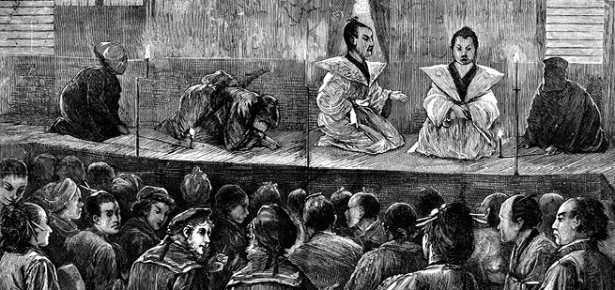
This year, the theme of the International Federation for Theatre Research conference is ‘Presenting the Theatrical Past: Interplays of Artefacts, Discourses and Practices‘, and asks questions about our relationship with theatre history. To explore these questions in detail ahead of the conference, Cambridge University Press asked members of the editorial board for Theatre Research International to delve into their archives and select articles that shed light on this theme, and which presented new ways of looking at the history of performance across the world when they were published.
Their selections can be found below, along with explanations for why they have selected these articles. You can also access the full ‘Presenting the Theatrical Past’ collection, which includes these articles from Theatre Research International, alongside articles from Theatre Survey, New Theatre Quarterly and Dance Research Quarterly, for FREE until 31 August 2016.
1) Charlotte Canning (TRI Editorial Board and former Senior Editor)
I have selected two articles from my time as Senior Editor of TRI:
‘Carnivalesque Homoeroticism in Medieval Decadent Cairo: Ibn Dāniyāl’s The Love-Stricken One and the Lost One Who Inspires Passion’ acquaints TRI readers with a figure who should be well known in world literature and yet is not. The article’s historiographical work makes a case for why we should know Ibn Dāniyāl’s dynamic, earthy and hilarious work. While largely ignored by scholars until the twentieth century, this ribald play demonstrates how theatre played a part in creating resistance to government repression of sexual practices.
‘Megaship Economies and Transnational Maritime Performance’ theorizes personal experiences of the transnational, offering us an intimate view of how the transnational is produced and experienced. The ‘maritime’ is a rare category in studies of transnational performance, but until very recently it was virtually the only way movement across continental borders could occur.
2) Silvija Jestrovic (TRI Editorial Board)
On the topic of ‘presenting the theatrical past’, this essay makes topical points about politics and censorship, integrating the paradigm of the public sphere in historical research of theatre.
This essay explores a traditional form – Beijing Opera – in a different temporal and cultural context to problematize the notion of hybridity. I like how this article not only ‘presents the theatrical past’, but also places the past into the conceptual frameworks of the present.
3) Diana Looser (TRI Editorial Board)
Innovative use of rare archival material to contextualize the historical meeting between Gordon Craig and Mei Lanfang in Moscow in 1935, and an intriguing analysis of Craig’s interpretation of, and interest in, Asian theaters.
I really enjoyed Helen Freshwater’s article for its lively and engaging style, its careful historiographic analysis, and its interesting arguments about censorship, spectatorship, and value.
4) Peter Marx (TRI Editorial Board)
I have picked two articles that I have found very interesting, partly because they cover less familiar topics, partly because their perspective is still speaking to the current discussion. The two are:
5) Sarah Balkin (TRI Assistant Editor)
This article argues for ‘responsibility to the pervasiveness of the commonplace’ (237) in theatre history via a focus on amateur British theatre. I like the article because it addresses a number of debates that have since become more central to theatre studies: amateurism, the need to consider non-peak performance, and the routine.
This article frames three major groups in nineteenth-century California – Americans, Chinese actors and audiences, and European visitors – as “needing” Chinese theatre for different reasons. I am particularly interested in Lei’s account of the Royal Chinese Theatre in San Francisco, which used hospitality and paratheatrical spectacle (lavish banquets and backstage invitations) as “the necessary social lubricant for Chinese theatre in a resistant environment” (296).
6) Margherita Laera (TRI Senior Book Reviews Editor)
These books intervene in debates that are still ongoing and have therefore proved somehow influential in provoking further debate.
This controversial volume is one of the very few theatre history books recently published in English that, having digested the critiques of positivism, presents a coherent narrative weaving different stories from world theatre cultures, with the unachievable ambition to be as ‘comprehensive’ as possible. Nonetheless, this book has re-read theatre history through the lens of performance studies, and went some way to busting many myths, including that of the birth of theatre in ‘classical’ Athens. Despite its flaws, as the reviewer points out, Theatre Histories remains a ‘goldmine’, and a site for productive discussions on historiography to be continued in Stockholm.
Bratton’s book is one of many particularly perceptive feminist historiography books which the field has produced in the past few decades, proposing a critique of the discipline which still resonates today. I have chosen this book not for its focus on Britain, but for its reflections on the question of what it might mean to ‘represent’ the past. Emerged out of discussions that Bratton had with colleagues at the Theatre Historiography Working Group at IFTR/FIRT, which was established in Stockholm in 1989, the book could be seen to ‘represent’ the history of the conference, and might be a good basis to reassess the field in the same city more than 25 years after the WG was established.
If the previous two books investigated histories of performance, this volume looks at the performance of history, that is, how performance can re-enact historical ‘events’, thus rewriting narratives, highlighting forgotten memories and making the past ‘present’. Always already haunted by ghosts, performance – and especially performance of past ‘events’ – complicates our fantasies of the linearity of time. There have been many publications around the issue of theatre as re-enactment of history since Rokem’s volume, such as Rebecca Schneider’s Performing Remains: Art and War in Times of Theatrical Re-enactment (2011), which have reminded us how memory not only is performed in theatre, but functions as a kind of performance in its own right.
Follow this link to browse all the articles in the ‘Presenting the Theatrical Past’ collection for free.
Latest Comments
Have your say!